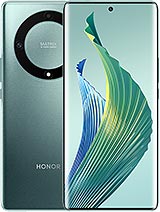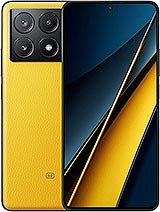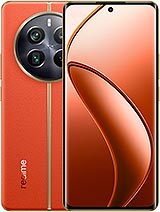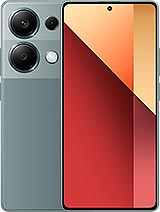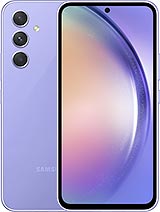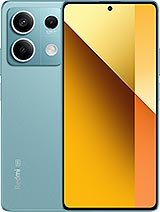Xiaomi Redmi Note 13 Pro+ review

Display
The Redmi Note 13 Pro+ has a 6.67-inch AMOLED display of top quality, one that is protected by a curved Gorilla Glass Victus sheet.
The panel itself is flat, of course, and offers plenty of niceties - 1220p (446ppi) resolution, 12-bit color depth, 120Hz refresh rate, 1920Hz PWM dimming, and HDR10+ and Dolby Vision support.

According to Xiaomi's official specs sheet, the screen has a peak brightness of up to 1,800 nits.
We've completed our display test, and the numbers are mostly in line with other Redmi Note 13 phones. We registered 486 nits of maximum brightness when controlling the brightness slider manually. Then, when using the Auto Brightness mode or with the Sunlight Boost enabled, the screen became much brighter at 1,283 nits.
The minimum brightness at point white was just 1.9 nit.
Refresh rate
The display supports up to 120Hz refresh rate, and there are two refresh modes - Custom (choose between 120Hz or 60Hz refresh ceilings) and Default (automatic switching behavior).
The screen should support the fixed 30Hz, 60Hz, 90Hz and 120Hz steps.
The adaptive refresh rate works as expected - it drops down to 60Hz when the screen shows static content. All streaming apps are capped at 60Hz for UI and streaming, too. And, of course, incompatible HFR apps such as the Camera app and Google Maps are always rendered at 60fps.
The only time we saw the screen use 30Hz was for the Always-on Display, which cannot be always-on all the time but appears only for 10s.
HDR video and streaming
The Redmi Note 13 Pro+ comes with Widevine L1 DRM support, and Full HD streaming with HDR10 and Dolby Vision support is available across popular platforms, Netflix included.
Battery life
Our new Active Use Score is an estimate of how long the battery will last if you use the device with a mix of all four test activities. You can adjust the calculation based on your usage pattern using the sliders below. You can read about our current battery life testing procedure here. For a comprehensive list of all tested devices so far, head this way.
The Redmi Note 13 Pro+ is powered by a 5,000mAh battery. Unfortunately, the Redmi Note 13 Pro+ posted unimpressive battery scores on our web (9 hours) and game (7 hours) battery tests. It did pretty well on the call and video playback tests, though, and scored an Active Use Score of 10:38 hours.
Charging test
The Redmi Note 13 Pro+, just like the Redmi Note 12 Pro+, supports 120W Xiaomi HyperCharge. The phone comes bundled with a 120W charger and an appropriate 6A-rated cable.

Just like other 120W charging-capable Xiaomi phones, this one also has Boost Charge mode. This is the feature that allows the fastest possible charging at 120W, but there is a catch - it works only when the phone is with its screen turned off as an overheating prevention measure. The Boost option is turned off by default, but you can enable it from within the Battery settings.
Oddly, there is another option called Speed Up Charging, which does exactly the same thing. It is part of the most recent MIUI 14 version and it is available to all Redmi Note 13 phones now. We cannot say what will happen if one of those is ON, and the other OFF, but this is certainly something Xiaomi needs to figure out and either communicate properly, or fix via an update on this particular Redmi Note model.
We did our charging test with the Boost mode, as otherwise, the phone is limited to 60W-80W charging.
The Redmi Note 13 Pro+ with its 120W GaN charger is an incredible combo. We got 31% of the charge in just 5 minutes, while 15 minutes replenished 67% of the battery. A full charge took 25 minutes, which is not exactly the advertised 19 minutes, but still incredibly fast.
During the 120W fast charging, the phone didn't get hot, just warm.
Speakers - loudness and quality
The Redmi Note 13 Pro+ features a stereo speaker system. One of the speakers is placed at the top of the phone and has two outlets - top-facing and front-facing for earpiece purposes. The other one is placed at the bottom.

The Redmi Note 13 Pro+ scored a Good mark on our loudness test. The sound quality is very good - the vocals are good, the high frequencies are well presented, and the bass is quite alright.
The Redmi Note 13 Pro+ supports Dolby Atmos enhancement, and it's enabled by default. We tried listening to music with and without Dolby Atmos, and we found the experience better when we kept it on - the speakers are a bit louder, and the audio is somewhat crisper. Turning the Dolby Atmos enhancement will make for an arguably richer sound with slightly better vocals, but the bass and the volume are a bit lower.
Use the Playback controls to listen to the phone sample recordings (best use headphones). We measure the average loudness of the speakers in LUFS. A lower absolute value means a louder sound. A look at the frequency response chart will tell you how far off the ideal "0db" flat line is the reproduction of the bass, treble, and mid frequencies. You can add more phones to compare how they differ. The scores and ratings are not comparable with our older loudspeaker test. Learn more about how we test here.
Reader comments
- Anonymous
- 12 hours ago
- BiP
Got Xiaomi redmi note pro plus just almost a week ago and love it ! After previously had Xperia 5 I have compared my new 13 pro plus with Xperia 5 and Xiaomi wins in all possible ways No.1 price No.2 speaker ( it's soooooooo loud ) No.3 camera (...
- MHDR
- 05 May 2024
- Tjx
Xiaomi 13T is better. But if you want cheap phone Redmi note 13's are good.
- Milos
- 28 Apr 2024
- nZi
Hi 😃 Have this phone for a few days already and it is pretty good for its price. This time decided not to buy Samsung because my A52 died after only 3 years of usage. But it seems to me that with updates Xiaomi cannot match Samsung,not even close. St...

